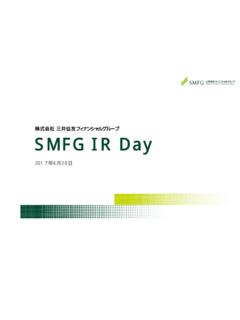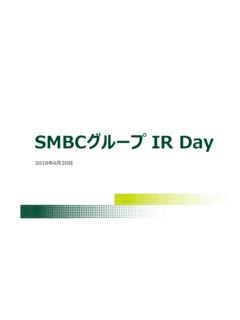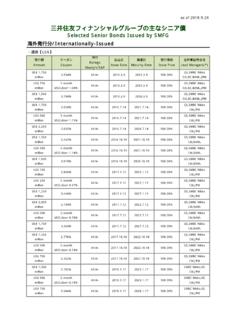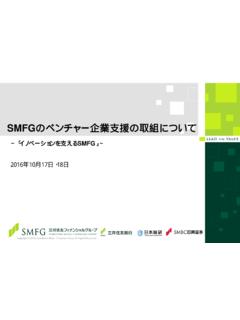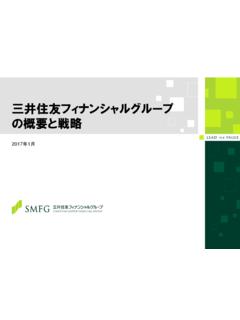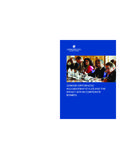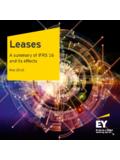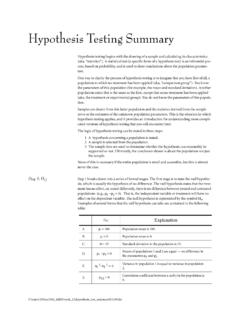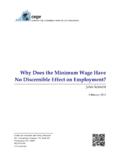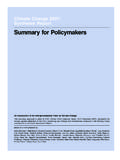Transcription of Summary of Significant Differences between …
1 Summary of Significant Differences between japanese gaap and gaap . The consolidated financial statements of SMFG and its subsidiaries presented in this annual report conform with generally accepted accounting principles in Japan ( japanese gaap ). Such principles vary from the accounting principles generally accepted in the United States ( gaap ). Significant Differences between japanese gaap and gaap are summarized below. These Differences are not necessarily the only Differences and other Differences may exist: japanese gaap gaap . Consolidated Subsidiaries Consolidated Subsidiaries The consolidated financial statements include all enterprises Statement of Financial Accounting Standards ( SFAS ). that are controlled by the parent, irrespective of the percent- No. 94 requires a parent company to consolidate all of its age of the voting shares owned. majority-owned subsidiaries with more than 50% of out- Control is defined as the power to govern the decision standing voting shares, subject to certain exceptions related making body of an enterprise.
2 To temporary control or the parent company's inability to exercise control over the subsidiary. As for consolidation of a special purpose entity, SFAS. No. 140 prescribes the definition of qualifying special purpose entity ( QSPE ) that is to be excluded from consoli- dation by transferor. To prescribe the consolidation of a special purpose entity other than QSPE, in January 2003, The Financial Accounting Standards Board (FASB) issued Interpretation No. 46, Consolidation of Variable Interest Entities, which applies immediately to variable interest entities created after January 31, 2003 and in the first fiscal year or interim period beginning after June 15, 2003 to older entities. An entity is considered a variable interest entity that is subject to consolidation under the Interpretation if the entity's total equity at risk is insufficient to permit the entity to finance its activities without additional subordinated financial sup- port or if equity investors lack one or three characteristics of a controlling financial interest.
3 Equity Method of Accounting Equity Method of Accounting Affiliates are enterprises over which SMFG has material influ- Investments representing ownership of 20% to 50% of the ence with respect to their financial and operating policies. outstanding voting shares are accounted for by the equity Investments in nonconsolidated subsidiaries or affiliates method. In addition, investments representing ownership of are accounted for by the equity method in the consolidated less than 20% are accounted for by the equity method if the financial statements. investor has the ability to exercise Significant influence over the entity in which it invests. Business Combinations Business Combinations Accounting treatment that is similar to the pooling- SFAS No. 141, Accounting for Business Combinations, pre- of-interest method is normally used for business combina- scribes the purchase method for all business combinations.
4 Tions in accordance with the Commercial Code of Japan. The purchase method requires the valuation of the acquired Under the accounting treatment, the balance sheet items of assets and liabilities based on fair market values at the time the acquired company are combined with those of the of combination. The difference between the fair market val- acquiring company at their carrying amount or fair value. ues of the net assets and the consideration given represents The Accounting Standards Board of Japan published goodwill. Opinion Concerning Establishment of Accounting Standard for Business Combination in October 2003. According to the opinion, from the fiscal year starting April 1, 2006, new accounting standard is required to be applied. Under the new accounting standard, purchase method is the basic method. Pooling of interests method is applied only to exceptionally limited circumstances when strict criteria are met.
5 SMFG 2004 105. Securities Securities Debt securities that consolidated subsidiaries have the intent Investments in marketable equity and all debt securities and ability to hold to maturity (held-to-maturity securities) are classified at acquisition according to management's are carried at amortized cost. Trading securities are carried at intent, into one of the following categories: trading, market value with gains or losses included in the current available-for-sale, or held-to-maturity. Trading securities period income. Other securities (available-for-sale securities) are marked to fair value, with the resulting unrealized are carried at fair value with unrealized gains or losses gain or loss recognized in income. Available-for-sale securi- recorded directly to stockholders' equity, net of taxes. ties should be marked to fair value, with the resulting unre- alized gain or loss recorded in other comprehensive income.
6 Held-to-maturity securities are carried at amortized cost. Other than temporary declines in value are charged to earn- ings when incurred. Accounting for Derivatives and Hedging Activities Accounting for Derivatives and Hedging Activities Derivative instruments are carried at fair value with changes SFAS No. 133, Accounting for Derivative Instruments and included in the current period income unless certain hedge Hedging Activities requires the recognition of all derivatives accounting criteria are met. In general, if derivative instru- as assets or liabilities in the balance sheet measured at fair ments are used as hedges and meet certain hedging criteria, value. Changes in the fair values of derivatives are included a company defers recognition of gains or losses resulting in earnings unless the derivative qualifies for hedge account- from changes in fair value of derivative instruments as either ing criteria.
7 As a result of assessing and measuring effective- an asset or liability until the related losses or gains on the ness of hedges, changes in fair values of ineffective portion of hedged items are recognized. As a result of assessing and derivatives are included in earnings and to be disclosed. The measuring effectiveness of hedges, changes in fair values of changes in the fair value of derivatives qualifying for hedge ineffective portion of derivatives can be deferred if only the accounting criteria depend on the intended use. total portion is recognized as effective. For derivatives designated as hedging the exposure to As for fair value hedge accounting to hedging transac- changes in the fair value of an asset or liability or a firm tions for reducing the exposure to market volatility of bonds commitment, the gain or loss is recognized in earnings in classified as other securities, a company can select either of the period of change together with the offsetting fair value following treatment.
8 Loss or gain on the hedged item. (a) A company defers recognition of gains or losses resulting For derivatives designated as hedging the exposure to from changes in fair value of derivative instruments as variable cash flows of a forecasted transaction, the effective either an asset or liability until the related losses or gains portion of the derivative's gain or loss is initially reported as on the hedged items are recognized. a component of other comprehensive income. Gains and (b) A company recognizes gains or losses resulting from losses of cash flow hedges included in other comprehensive changes in fair value of derivative instruments in earn- income are reclassified into earnings in the same period or ings in the period of change together with the offsetting periods during which the related asset or liability affects fair value loss or gain on the hedged item.
9 Earnings. A bank was permitted to adopt Macro Hedge For derivatives designated as hedging the foreign cur- Accounting as hedge accounting method, under which the rency exposure of a net investment in a foreign operation, bank manages the total interest rate risk arising from various the gain or loss is reported in other comprehensive income as financial assets and liabilities as a whole by using financial part of the cumulative translation adjustment. derivative transactions. The treatment was temporarily SFAS No. 133 was partially amended by SFAS No. 138. permitted until fiscal year starting April 1, 2002. and SFAS No. 149. From the fiscal year starting April 1, 2003, japanese banks are required to apply the basic provision of JICPA. Industry Audit Committee Report No. 24 to hedges on groups of large-volume, small-value monetary and debts with similar risk characteristics.
10 Accounting for Sales of Loans with Recourse Accounting for Sales of Loans with Recourse Certain loan participations which meet specified criteria are Under gaap , pursuant to SFAS No. 140, financial allowed to be accounted for as sales, even though the loans assets are generally recorded as sold and removed from the are not legally isolated from the transferor. balance sheet only when the following conditions have been met: legal title has passed; the financial assets are beyond the reach of the transferor's creditors, even in bankruptcy or receivership; the purchaser obtains the asset free of 106 SMFG 2004. conditions that constrain it from taking advantage of the right to pledge or sell the asset; and the transferor does not maintain effective control over the assets as defined. Sales that are not free of such constraints are recorded as a financ- ing. A transfer of assets qualifying as a sale under gaap but in connection with which the seller has assumed a limited recourse obligation would result in the recording of a liability for the estimated recourse.



